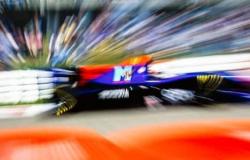The variations that might be required by a track like that of Shanghai might not be at all the enemy of the Ferrari SF-24 compared to the Red Bull RB20. And the unknown of the first match with the new format adds further uncertainty
The Chinese GP will take place this week in Shanghai, five years after the last edition in 2019. In practice it will be like a sort of new debut, as the ground effect single-seaters will take to the Chinese track for the first time, also equipped with tires mounted on 18-inch rims instead of the 13s of the last GP held on this track. Hence the skepticism, or rather the criticism from several drivers with Verstappen and Perez in the lead, regarding the appropriateness of the choice to contest the first Sprint of this season in China. That said, this climate of uncertainty, i.e. the fact of not having valid data to be able to imagine a valid aerodynamic and above all dynamic set-up, can be seen as an opportunity, especially for those teams that over the last two seasons have demonstrated have and know how to use simulation tools particularly effectively.
heights from the ground
—
The fears expressed by Verstappen and Perez should not lead one to think that Red Bull is weak in the field of simulations, but they undoubtedly highlight an objective fact that at first glance might even seem paradoxical. The RB20, as was the RB19, is a single-seater that does not require particular adjustments on tracks where there are no obvious irregularities in the asphalt surface. In essence, regardless of the layout, since the peculiar characteristic of this car was not the extremes of the achievable load levels, but rather the adaptation to the widest range of tracks, the set-up chosen is always “intermediate” or not taken to the extreme maximum in terms of heights from the ground, although the sliding of the central board placed under the bottom is evident. This condition, however, represents in itself a sort of vulnerability factor in the case in which the structure must be optimized in terms of variation in height from the ground, especially in the case in which, due to disconnections in the asphalt surface, it is necessary to increase it or stiffen the dynamic response of the shock absorbers.
extreme set-up
—
In these conditions, the type of single-seater that prefers an extreme type of setup becomes more effective on average. In essence, practically as in the case of the Ferrari SF-24, one of the cars that on average has minimum ground clearances. In the case of adaptation to particularly bumpy tracks, in fact, the platform remains more performing in terms of structure, as the variation in suspension stiffness, rather than a minimal increase in height from the ground, generates a loss of performance that is decidedly less evident than on a car like the RB20.
Don’t miss the entire new season of Formula 1® and MotoGP™ live streaming only on NOW! Activate the Sports Pass from €9.99 per month and enjoy Sky sports in streaming!
the sprint unknown
—
Added to this is the fact that the Sprint format is being adopted this weekend. This, in fact, makes it impossible to refine the basic set-up during the single free practice session, granting an advantage both to the single-seaters of the type that prefers the setup to the extreme, and to the teams that over the last year have shown important progress in dynamic simulations. It is no coincidence that Ferrari itself proved particularly effective during the Sprint weekends last year. In essence, net of the performances shown in the first four races, the Chinese GP could, similarly to what was seen in Melbourne (net of reliability) constitute a terrain in which the values on the field could be extremely close, if not even , subverted.
© ALL RIGHTS RESERVED




